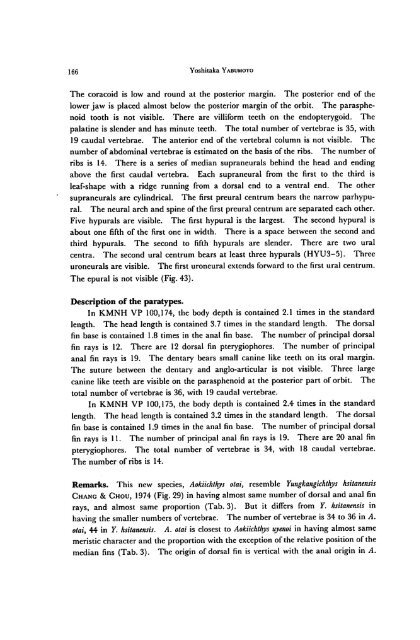Early Cretaceous Freshwater Fish Fauna in Kyushu, Japan
Early Cretaceous Freshwater Fish Fauna in Kyushu, Japan
Early Cretaceous Freshwater Fish Fauna in Kyushu, Japan
You also want an ePaper? Increase the reach of your titles
YUMPU automatically turns print PDFs into web optimized ePapers that Google loves.
jgg<br />
Yoshitaka Yabumoto<br />
The coracoid is low and round at the posterior marg<strong>in</strong>. The posterior end of the<br />
lower jaw is placed almost below the posterior marg<strong>in</strong> of the orbit. The parasphe<br />
noid tooth is not visible. There are villiform teeth on the endopterygoid. The<br />
palat<strong>in</strong>e is slender and has m<strong>in</strong>ute teeth. The total number of vertebrae is 35, with<br />
19 caudal vertebrae. The anterior end of the vertebral column is not visible. The<br />
number ofabdom<strong>in</strong>al vertebrae is estimated on the basis of the ribs.<br />
The number of<br />
ribs is 14. There is a series of median supraneurals beh<strong>in</strong>d the head and end<strong>in</strong>g<br />
above the first caudal vertebra. Each supraneural from the first to the third is<br />
leaf-shape with a ridge runn<strong>in</strong>g from a dorsal end to a ventral end. The other<br />
supraneurals are cyl<strong>in</strong>drical. The first preural centrum bears the narrow parhypural.<br />
The neural arch and sp<strong>in</strong>e of the first preural centrum are separated each other.<br />
Five hypurals are visible. The first hypural is the largest. The second hypural is<br />
about one fifth of the first one <strong>in</strong> width. There is a space between the second and<br />
third hypurals. The second to fifth hypurals are slender. There are two ural<br />
centra. The second ural centrum bears at least three hypurals (HYU3-5). Three<br />
uroneurals are visible.<br />
The epural is not visible (Fig. 43).<br />
The first uroneural extends forward to the first ural centrum.<br />
Description of the paratypes.<br />
In KMNH VP 100,174, the body depth is conta<strong>in</strong>ed 2.1 times <strong>in</strong> the standard<br />
length. The head length is conta<strong>in</strong>ed 3.7 times <strong>in</strong> the standard length. The dorsal<br />
f<strong>in</strong> base is conta<strong>in</strong>ed 1.8 times <strong>in</strong> the anal f<strong>in</strong> base. The number of pr<strong>in</strong>cipal dorsal<br />
f<strong>in</strong> rays is 12. There are 12 dorsal f<strong>in</strong> pterygiophores. The number of pr<strong>in</strong>cipal<br />
anal f<strong>in</strong> rays is 19. The dentary bears small can<strong>in</strong>e like teeth on its oral marg<strong>in</strong>.<br />
The suture between the dentary and anglo-articular is not visible. Three large<br />
can<strong>in</strong>e like teeth are visible on the parasphenoid at the posterior part of orbit. The<br />
total number of vertebrae is 36, with 19 caudal vertebrae.<br />
In KMNH VP 100,175, the body depth is conta<strong>in</strong>ed 2.4 times <strong>in</strong> the standard<br />
length. The head length is conta<strong>in</strong>ed 3.2 times <strong>in</strong> the standard length. The dorsal<br />
f<strong>in</strong> base is conta<strong>in</strong>ed 1.9 times <strong>in</strong> the anal f<strong>in</strong> base. The number of pr<strong>in</strong>cipal dorsal<br />
f<strong>in</strong> rays is 11. The number of pr<strong>in</strong>cipal anal f<strong>in</strong> rays is 19. There are 20 anal f<strong>in</strong><br />
pterygiophores. The total number of vertebrae is 34, with 18 caudal vertebrae.<br />
The number of ribs is 14.<br />
Remarks. This new species, Aokiichthys otai, resemble Yungkangichthys hsitanensis<br />
Chang & Chou, 1974 (Fig. 29) <strong>in</strong> hav<strong>in</strong>g almost same number of dorsal and anal f<strong>in</strong><br />
rays, and almost same proportion (Tab. 3). But it differs from Y. hsitanensis <strong>in</strong><br />
hav<strong>in</strong>g thesmaller numbers ofvertebrae. The number ofvertebrae is 34 to 36<strong>in</strong> A.<br />
otai, 44 <strong>in</strong> Y. hsitanensis. A. otai is closest to Aokiichthys uyenoi <strong>in</strong> hav<strong>in</strong>g almost same<br />
meristic character and the proportion with the exception of the relative position of the<br />
median f<strong>in</strong>s (Tab. 3). The orig<strong>in</strong> of dorsal f<strong>in</strong> is vertical with the anal orig<strong>in</strong> <strong>in</strong> A.

















